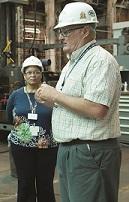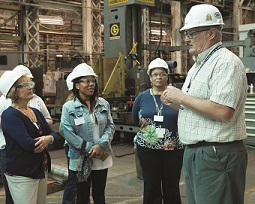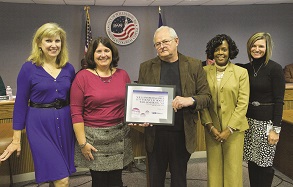

There is an urgent need to develop a collaborative, “cradle to career” approach to graduating literate, career-ready citizens. None of us — manufacturers, educators, families and community/government resources – can achieve this goal alone. The 2013 National Assessment of Educational Progress (NAEP)1 report indicates that only 34 percent of U.S. fourth- and eighth-grade students met or exceeded the NAEP proficiency standard. Struggling readers come from all backgrounds and might include economically disadvantaged youngsters, English-language learners and students with dyslexia or other learning disabilities. It is estimated that 95 percent of all children can learn to read proficiently, especially when given reading instruction validated by science and based on data outcomes. Students in high-risk populations need not fail at the current rates. Placed in schools with effective principals and well-prepared and well-supported teachers, economically or otherwise disadvantaged children can learn to read as well as their more advantaged peers.
Learn how young children can be provided a nurturing environment that promotes learning/reading, prepare them to read at grade level by the end of third grade and then continue to advance their reading and comprehension skills through high school and beyond. Action: Contact local educators and ask about needed resources for overcoming reading proficiency gaps. The Association for Manufacturing Excellence’s (AME’s) Adopt-a-School Program, for example, provides guidance for effective industry/education partnerships. Through this program, participants in an adopted school or community college receive a corporate membership in AME, enabling teachers and students to attend AME events at member prices. Participating schools will receive copies of AME’s Target magazine to increase awareness of what will be required for career readiness in manufacturing, logistics and related areas.
Get involved in initiatives for introducing reading and skills training that will promote job-readiness capabilities. According to a report by the Information Technology & Innovation Foundation, the number of STEM (science, technology, engineering and math) and healthcare graduates must increase 20-30 percent by 2016 to meet the projected growth of the U.S. economy. While new and available jobs require more advanced skills every day, 2.2 million people are added to the adult illiterate population each year. Consider the high unemployment rate for the nation’s teenagers (missing opportunities to build experience they will need later in life) and more than 92 million people of working age who are not participating in the workforce. Such unemployment and under-employment costs taxpayers millions of dollars in public assistance and potential future prison costs. Action: Get involved with the STEM Education Coalition2 and other organizations fostering awareness/action to support STEM education programs.
Participate in launching an educational and manufacturing renaissance to provide a high-quality, literacy-rich environment — a prerequisite for academic and economic success. The Literacy Education for All, Results for the Nation (LEARN) Act3 proposes comprehensive state and local literacy programs to ensure that children from birth to grade 12 have the reading and writing skills needed for success in school and beyond. Action: Visit the Literate Nation website for information on tools and knowledge supporting literacy solutions.
Reach out to local and regional organizations with shared concern about the crucial need for building literacy and job readiness skills/understanding. One example, the Literate Nation-Virginia Coalition4, is working to graduate more literate, career-ready citizens and supports the school-dropout-reduction initiative led by America’s Promise Alliance.
The Youth Promise Act5, when implemented, will fund evidence-based practices to interrupt the cradle-to-prison pipeline that is far too common today. The act will encourage and require leadership and oversight of these programs through community-based committees. Research shows that evidenced-based prevention programs for at-risk youth save much more than they cost.
There will be 55 million new jobs by 2020, but not enough post-secondary-educated workers. The U.S. Department of Commerce reported that manufacturing jobs draw 17 percent higher compensation benefits versus non-manufacturing jobs. Your support for literacy and workforce readiness programs will help to create and develop talent for tomorrow’s manufacturing workforce.

While it is important to address literacy issues and workforce readiness for those who have yet to enter the workforce, there is also a golden opportunity to promote manufacturing as a desirable career among adults who are looking at making a career move or re-entering the workforce after military service.
In conjunction with the AME Institute and Kronos Inc., AME offers the Dr. Sherrie Ford Manufacturing as a Career Path Scholarship to U.S.-based student applicants entering an accredited college or trade school in the next academic year. Each scholarship recipient will receive $1,500 through the scholarship. An additional $500 signing bonus will be offered to those recipients who complete their programs and enter the manufacturing workforce. Eligible applicants include individuals who are currently graduating from high school or those with prior work experience who are seeking a college education. If you know anyone entering a manufacturing program please send them to AME's website for a scholarship application6.The next application deadline is November 7.
AME launched the AME Values Veterans Program (AMEV2) in March 2014 to help energize America’s economy and help America’s employers understand how to re-capitalize their workforce through recruiting, hiring, training and retaining veterans.
Most veteran employment programs focus on reduction of unemployment numbers for veterans as a charitable activity versus a great business decision. American business can profit from hiring and retaining veterans because they are disciplined, have the technological base and have experienced a continuous improvement environment.
The AMEV2 Program is an outstanding way for businesses to gain valuable strategies for hiring employees who are talented, loyal, who show up on time, take direction well and thrive in a team environment. AME is hosting free symposia throughout the country. These events are free to AME members and are a great way to learn how to find the right veteran for your organization. In some cases, AME has brought in manufacturers who have hired veterans to discuss examples of how veterans have consistently out-performed their peers and significantly contributed directly to their employers’ bottom lines.
AME, with its alliance partners, works with communities, educators in schools and colleges, as well as other organizations toward a collective impact approach for addressing the nation’s talent shortage. The objective is to prepare and graduate literate, career-ready citizens with the proper education and the right skills needed to qualify for high-paying jobs — and then let them lead the way in designing and building things at home again.
About The Association for Manufacturing Excellence
The Association for Manufacturing Excellence (AME) is a not-for-profit organization dedicated to the journey of continuous improvement and enterprise excellence. AME members, a network of volunteers, are committed to leveraging the practitioner-to-practitioner and company-to-company shared-learning experience. Through workshops, seminars, plant tours and industry-leading conferences, AME members discover and implement continuous improvement strategies and best practices. AME offers its members valuable resources to help them stay abreast of current industry developments and to improve the competitiveness/success of their organizations.
_____________________________________
References
1 The 2013 National Assessment of Educational Progress (NAEP) report http://www.doe.virginia.gov/news/news_releases/2013/nov07_gov.shtml
2 STEM Education Coalition http://www.stemedcoalition.org/
3 The Literacy Education for All, Results for the Nation (LEARN) Act http://literatenation.org/wp-content/uploads/2013/10/LiterateNationVACoalitionBriefRevised.pdf
4 Literate Nation-Virginia Coalition4 http://literatenation.org/wp-content/uploads/2013/10/LiterateNationVACoalitionBriefRevised.pdf
5 The Youth Promise Act http://youthpromiseaction.org/about-bill.html
6 The AME Scholarship Program application http://www.ame.org/manufacturing-scholarship-program

